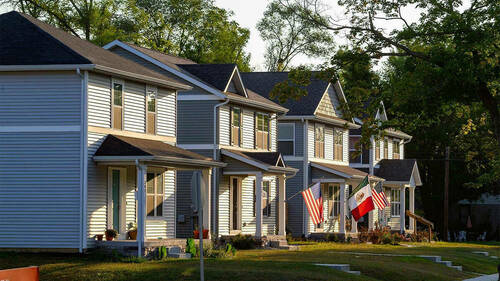
Last summer, interns with the University of Notre Dame’s Center for Civic Innovation (CCI), in collaboration with the University’s Fitzgerald Institute for Real Estate (FIRE), helped evaluate the historical pattern of residential development in South Bend to illustrate how prototypes for new infill housing might fit into existing neighborhoods — part of a plan to offer pre-approved building plans to prospective homebuyers and developers free of charge.
Now, after more than a year of additional design work, including revisions and approvals, city leaders are heralding the end product — an online catalog of pre-approved building plans designed to encourage new infill housing by narrowing the gap between the cost of a new home and its ultimate value in areas of the city with relatively low property values.
The catalog offers a range of contextually appropriate building types — carriage house, narrow house, standard house, stacked duplex and small apartment — based on current zoning laws and lot sizes, as well as building materials and methods and market conditions.
“This is a continuation of city efforts to support neighborhood infill and economic opportunities for locals by offering a set of pre-approved building types free of charge,” South Bend Mayor James Mueller said. “Small to middle scale housing development in South Bend neighborhoods plays a critical role in supporting locally serving retail and public transportation options while also providing key solutions for housing affordability.”
Critically, the building types meet the need in the city for more “missing-middle housing” — a term coined to describe the range of multi-family or clustered housing types that meet the growing demand for walkable, urban neighborhoods, but at more affordable price points than the typical detached, single-family home.
In evaluating the designs, the interns, including Notre Dame students Isabella Botello (architecture) and Angelique Mbabazi (engineering), reviewed a database of vacant lots and conducted research to inform the location and design of new housing units with a focus on scale and context. They then tested the prototypes on existing lots to show proof of concept.
The city is leading several new initiatives to improve housing affordability. By offering these pre-approved plans at no cost, it expects to save homebuyers and developers thousands of dollars on the cost of a new single-family home or apartment building. The city is also helping to cover sewer hook-ups for new infill housing, up to $20,000. And it administers a tax abatement program for new home construction citywide.
Combined, these and other incentives, along with lower construction costs for some missing-middle housing types, aim to reduce or eliminate the “appraisal gap” — the difference between the cost of a new home and its finished value — in areas of the city beset by long-term decline and disinvestment, making it more attractive for individuals and developers, as well as lenders, to invest in such areas.
“The city continues to look for creative and innovative ways to support infill development in our urban neighborhoods,” said Elizabeth Maradik, director of neighborhood health and housing for the city, who led the design process for the pre-approved building types along with city planner Tim Corcoran and urban design and architecture consultants Jennifer Griffin and Jennifer Settle, both graduates of the Notre Dame School of Architecture. “The pre-approved plans are tool to encourage new construction on vacant lots.”
Jason Arnold, program director of the Architecture and Real Estate Development Initiative at FIRE, said: “We are thrilled to see South Bend leading the way to address housing affordability across the city through these kinds of unique initiatives. We continue to look for ways to partner with them and their residents, to leverage our expertise, and to provide opportunities for our students to learn from industry leaders.”
Notre Dame has a history of contributing to community and economic development in the South Bend-Elkhart region, from brick-and-mortar projects such as Eddy Street Commons, the Notre Dame Turbomachinery Facility and the Idea Center, to business and workforce development projects such as iNDustry Labs. This extends to the School of Architecture, which recently began collaborating with local governments to restore and revitalize urban neighborhoods.